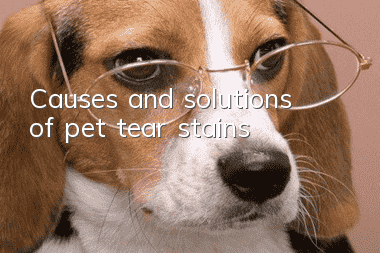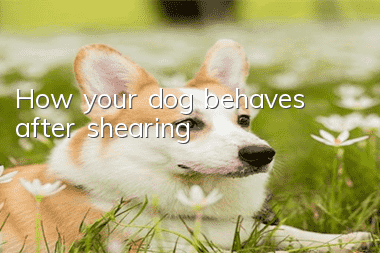Causes and solutions of pet tear stains

The pet's lacrimal gland is an important accessory organ of the eye. Its main function is to secrete tears to moisturize the eyeball. Under normal circumstances, the lacrimal gland secretes tears to moisturize the eyeball and then enters the nasal cavity through the tear duct and will not flow out from the corner of the eye. If for some reason the lacrimal gland secretes too much tears If it cannot be discharged from the nasolacrimal duct, tears will flow from the corners of the eyes. Over time, the hair moistened by excessive tears will leave brown tear stains [1]. Tear stains not only affect the appearance of the pet's face, but severe and continuous tearing can also become a breeding ground for a series of bacteria, fungi, and fleas, causing eye infection and inflammation, causing physical pain to the pet.
1. Causes of pet tear stains
1.1 Diet
With the improvement of living standards, the types of pet food are becoming increasingly rich. Different brands of pet food have different nutritional components and are suitable for different groups of pet dogs and cats. Additives, grains, etc. in pet food may cause allergic symptoms, thereby indirectly Causes increased tear secretion. Excessive tears overflow out of the eyes. Tears contain lactoferrin, which is easily oxidized and turns into reddish brown. It looks like rust in appearance and affects the appearance of pets.
1.2 Physiological structure
Dogs’ eyes shed tears in the wind. Once the tear glands are blocked and inflamed, tear stains will easily form. In some breeds of pet dogs, especially those with short noses, the nasolacrimal ducts of these types of dogs have large curvatures. Even normally secreted tears often cannot be discharged through the nasolacrimal ducts, and when they flow from the corners of the eyes, they will form tear stains or even Dark eyes. In addition, if the hair around the dog's eyes is too long, it will always stick into the eyes and continue to irritate the cornea or conjunctiva, which will also cause the dog to shed tears abnormally and form tear stains.
1.3 Disease
1.3.1 Ear canal infection
When a pet’s ear canal is infected by bacteria or viruses, mold, or parasites, or the ear is swollen, painful, or itchy, it will cause the dog to frequently scratch its ears with its hind feet [2]. The auditory nerve and facial nerve are interlaced on the pet's face, which is a very sensitive area. Because the pain in the deep ear canal will extend to around the eyes, it will also stimulate the secretion of lacrimal glands. When too many tears are not discharged from the nasolacrimal duct in time, It will overflow from the corner of the eye near the nose. After a long period of accumulation, the brown tear stains on the hair will be very obvious.
1.3.2 Nasolacrimal duct obstruction
When the nasolacrimal duct becomes infected and becomes inflamed and swollen, the entire tear duct is completely or incompletely blocked, and tears cannot be discharged from the nasolacrimal duct normally, thus forming unsightly tear stains.
1.3.3 Eye inflammation
When the lacrimal glands, conjunctiva, or cornea of pets' eyes are infected by viruses or bacteria, they often cause abnormal and large amounts of tear secretion, and the nasolacrimal ducts have no time to clear the excess tears, thus causing tears to flow out. Tears are a weak baseIt is a transparent liquid containing inorganic salts, proteins, lysozyme, oleamide and other substances, which over time forms unsightly reddish-brown tear stains. Eye inflammation is the main cause of pet tear stains.
2. Solutions to pet tear stains
2.1 Dietary nutrition
With the improvement of living standards, pet owners have evolved from feeding simple rice bones to a wide variety of pet foods. Artificial colors, additives, preservatives, etc. in pet food may cause allergic symptoms, which indirectly leads to increased tear secretion. Therefore, you should pay attention to whether your pet frequently rubs its face with its feet, licks its front feet, shakes its head, etc., so as to detect allergic symptoms in time. If you have allergic symptoms, you can change it to food suitable for dogs and cats, and pay attention to appropriately increasing water intake.
2.2 Physiological structure
2.2.1 Tear duct stenosis and occlusion
For some dogs and cats with relatively large and protruding eyes, the large eyeballs will compress the nasolacrimal duct, forcing tears to flow out of the eye sockets. During clinical diagnosis, 1% fluorescein solution can be dropped into the conjunctival sac. The dye will appear in the nostrils within 10 minutes, proving that the tear duct is unobstructed, otherwise the tear duct will be blocked. For general symptoms, you can first determine the dog's tear points, then use professional equipment to flush the tear ducts, and carefully observe whether the tear ducts are unobstructed. If it doesn't work once, you can repeat it several times. If it still cannot be flushed after repeated operations several times, it is recommended to perform nasolacrimal duct intubation surgery.
2.2.2 Congenital punctal atresia
The most common condition of congenital punctal atresia is lacrimal atresia. During diagnosis, the ocular surface can be anesthetized first, a blunt needle can be inserted into the upper punctum and lacrimal canaliculus, and a syringe filled with physiological saline can be connected and rinsed slowly. If the fluid is drained from the lower puncta, it proves that the upper and lower puncta and the lacrimal canaliculus are unobstructed. When the punctum and nasolacrimal duct are pressed with finger pressure, if the liquid flows into the throat (with symptoms of swallowing or gagging) or is discharged from the nostrils, it proves that the nasolacrimal duct is unobstructed.
Punctal reconstruction surgery can be performed for atretic puncta. If irrigation is carried out according to the method during diagnosis, a localized bulge will appear on the inside of the lower eyelid edge of the inner corner of the eye at the beginning of irrigation, which is the normal position of the tear point. A small round piece of conjunctiva can be removed with a surgical blade or scissors. After surgery, chloramphenicol eye drops were used to prevent infection, and a collar was added to prevent scratches on the front paws.
2.3 Disease
2.3.1 Ear canal infection
Ear canal diseases in pet dogs and cats are common. Because the ear structure of dogs and cats is wrinkled and hairy, daily care is difficult. If cleaning is often neglected or care is not thorough, the dirt in their ears will breed a large number of bacteria, fungi, and become infected with ear mites and other parasites. , causing itching, dermatitis or otitis externa and other diseases in pets. In this case, you can ask a doctor to diagnose the cause of the ear canal infection and then choose the correct treatment. After the ear canal disease is treated, tears return to normal secretion and tear stains become less likely to form.
2.3.2 Nasolacrimal duct inflammation
For blockage caused by inflammation and swelling of the nasolacrimal duct, generally speaking, veterinarians will recommend treatment with antibiotics and, if necessary, minor surgery to clear the nasolacrimal duct. The method and frequency of this treatment will depend on the severity of the symptoms. It may take several times to clear the nasolacrimal duct to solve the problem of nasolacrimal duct obstruction.
2.3.3 Eye inflammation
Eye inflammation is very common in dogs and cats. The causative factors are complex and the symptoms are diverse. Many are accompanied by excessive secretion of tears and the formation of tear stains. Inflammation caused by virus, bacteria, chlamydia or mycoplasma infection usually occurs in one eye initially, and the other eye also develops after a few days or a week. Topical broad-spectrum antiviral and antibacterial eye drops are an effective and easy-to-use method. treatment methods. "Yan Meijing" eye drops are developed to treat tears caused by eye inflammation. The active ingredients in it have broad-spectrum bactericidal and antiviral effects, and also contain nutrients that promote corneal repair and help reduce inflammatory reactions. When using it, you can use a 2% boric acid (or cold water) cotton ball to gently wipe it from the inner corner of the eye outward, and carefully check whether there is any foreign matter behind the conjunctival sac. After wiping, instill eye drops into the pet's eyes. After the symptoms improve, , can reduce the frequency of instillation. After the inflammation is eliminated, the tears will return to normal.
The formation of canine tear stains has a great impact on the appearance of the dog. Pet owners should focus on prevention in daily care. Once tear stains form, they should carefully analyze the reasons and take appropriate measures as soon as possible. After the tear stains disappear, they should also pay attention to their daily routine. Eye care to prevent recurrence.
References
[1] Gao Deyi. Canine and Cat Diseases[M]. Beijing: China Agricultural University Press, 2001:281.
[2] Zhang Zhihong, Hu Ping, Sun Bo, et al. Typing of Malassezia in the ear canal of dogs with otitis externa and in vitro drug susceptibility test [C]. 2008 Academic Annual Meeting of the Chinese Association of Animal Husbandry and Veterinary Medicine and the Sixth National Youth Animal Husbandry and Veterinary Medicine Conference Proceedings of the Academic Symposium of Scientific and Technological Workers, 2008: 427.
- How to better train a Border Collie? A must-read for novices!
- A dog's increased appetite is not just for body growth, it may be sick itself!
- What should I do if my dog gets injured in a fight? Scratches and bites make a big difference
- The most painful time for male dogs after neutering surgery
- How to raise a Husky? Husky Breeding Guide!
- How is dog coronavirus transmitted?
- What to do if your dog vomits undigested food
- How much does a Jingtian Beast cost? Is it easy to raise? Appearance and characteristics of Jingtian Beast_Pictures
- What should I do if Su Mu has a skin disease?
- How many days does it take to start training a puppy? The best time to train a puppy!



